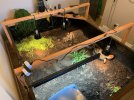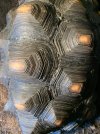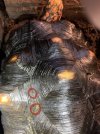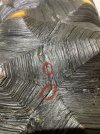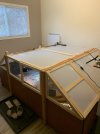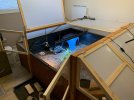Emiliar33
New Member
Two years ago, we adopted an adult red foot tortoise. When we got her, she had significant pyramiding, but since we got her, the growth between her scutes has been really rough looking, with some imperfections. She is currently 8 years old (we think), she is 13inches long, and weighs 14-15 pounds. She eats and drinks well, and has recently been given a clean bill of health by her vet.
I feel like we are doing as much as we can to meet her needs, but the rough and wobbly texture of her shell growth tells me that I am missing something. Has anyone ever seen this? The vet seemed to think it was stuck keratin, and that I should be gently scrubbing her shell when she gets her soaks, but it doesn’t seem to be helping.
Living parameters are as follows:
- 6’x8’ enclosure.
- humidity kept at 70-75% with humidifiers and moist substrate.
- ambient temps between 80-90 degrees. She does have one warm corner that sits around 95 and one cool corner that sits around 75.
- substrate is coconut coir mixed with soil
- she has a 4ft long t5 uvb lamp, three heat lamps, a ceramic heat emitter (on a thermostat), and a space heater in the room (also on a thermostat) to keep her comfy.
- for diet, we give her a variety of greens with some veggies and fruits. She is also free fed Mazuri tortoise diet. We supplement her food with calcium/multi vitamins a 2-3 times a week.
- She gets soaks almost daily for 15-20 minutes.
We live in Canada, so this description is for her indoor/winter home. During the summer, we have an outside enclosure for her that is larger, and that we are able to keep within similar parameters, however, she always spends the night in her indoor enclosure.
I have attached some photos of her shell and enclosure set up. Any information would be greatly appreciated.
I feel like we are doing as much as we can to meet her needs, but the rough and wobbly texture of her shell growth tells me that I am missing something. Has anyone ever seen this? The vet seemed to think it was stuck keratin, and that I should be gently scrubbing her shell when she gets her soaks, but it doesn’t seem to be helping.
Living parameters are as follows:
- 6’x8’ enclosure.
- humidity kept at 70-75% with humidifiers and moist substrate.
- ambient temps between 80-90 degrees. She does have one warm corner that sits around 95 and one cool corner that sits around 75.
- substrate is coconut coir mixed with soil
- she has a 4ft long t5 uvb lamp, three heat lamps, a ceramic heat emitter (on a thermostat), and a space heater in the room (also on a thermostat) to keep her comfy.
- for diet, we give her a variety of greens with some veggies and fruits. She is also free fed Mazuri tortoise diet. We supplement her food with calcium/multi vitamins a 2-3 times a week.
- She gets soaks almost daily for 15-20 minutes.
We live in Canada, so this description is for her indoor/winter home. During the summer, we have an outside enclosure for her that is larger, and that we are able to keep within similar parameters, however, she always spends the night in her indoor enclosure.
I have attached some photos of her shell and enclosure set up. Any information would be greatly appreciated.
